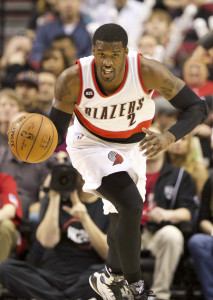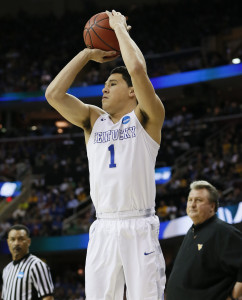The Blazers head into the offseason with several question marks, one being the status of Wesley Matthews. The shooting guard tore his left Achilles tendon on March 5th, 60 games into the season. Portland went 41-19 with the guard in the lineup and just 10-12 without him. The Marquette product averaged 15.9 points and 1.3 steals per game and sported a player efficiency rating of 16.1. He shot 38.9% from behind the arc and only MVP Stephen Curry and Warriors backcourt-mate Klay Thompson made more three-pointers per game.
Shooting wasn’t the only thing Matthews excelled at this season. His defense was just as impressive as his offense, as he ranked fifth among shooting guards in ESPN’s Defensive Real Plus/Minus. He played a good chunk of his minutes next to point guard Damian Lillard, who has a negative Defensive Real Plus/Minus. Despite employing such a defensive liability at the point guard position, the team ranked third in the league in defensive efficiency leading up to his injury. In the 22 games without him, the team ranked 24th.
Jeff Austin, Matthews’ agent, is likely to cite all of the above in the guard’s contract negotiations this summer. Many of the teams in the league are transitioning to a pace-and-space style of play and because of his shooting range and ability to play efficiently without the ball in his hands, Matthews should have no shortage of suitors. Before the injury, Matthews was in line to see a hefty raise on his roughly $7.25MM salary and he could have seen a salary that approached the max, although that is just my speculation.
The injury complicates things, though while he may not even be ready for the beginning of the season, he’s said he expects to return to the court well in advance of opening night (video link). It’s unclear what kind of offer teams will be willing to give Matthews in July. Signing a one-year deal to prove his health, re-establish his stock and enter the free agent pool next offseason when the salary cap is expected to reach $89MM might be beneficial for the sixth-year veteran. Yet, he could also, with great trepidation, simply seek the highest guaranteed salary he can get this summer. The 28-year-old has made it known that he would like to re-sign with the Blazers.
“So much stuff can happen between now and when free agency starts,” Matthews said in response to a question about returning to Portland. “Ideally, perfect situation, yeah, who doesn’t want to go for the ideal, perfect situation?”
The status of free-agent-to-be LaMarcus Aldridge could be a factor in his decision. One of Aldridge’s teammates reportedly believes it is a 50-50 proposition whether the power forward leaves Portland. If the Blazers lose the former No. 2 overall pick to free agency and cannot add an All-Star caliber replacement, like Paul Millsap, it would be unlikely they contend for a playoff spot in the Western Conference.
If Portland doesn’t remain a contender, I’d imagine it would like to rebuild a younger team around Lillard. Playing on a young team without any real playoff aspirations wouldn’t be in Matthews’ best interest, especially if he decides to go with a one-year-prove-it deal. Whether he intends to sign that kind of deal or not, this scenario would give outside suitors an advantage in courting Matthews since he would probably be in his early 30s by the time Portland is ready to contend again.
New York was reportedly planning to target the 28-year-old in free agency and the team employs the NBA Trainers Association’s 2014 Physician of the Year. Yet, the Knicks haven’t exactly been a stable franchise known to rehabilitate players’ values and Matthews’ injury probably dilutes their interest anyway. The Celtics are reportedly “open to putting together some type of package deal” for Aldridge and Matthews. Boston has a stable front office but hasn’t been a real contender in a few years.
A franchise that’s stable, has won recently, and has a history of rehabilitating player values resides in Dallas. Brandan Wright and O.J. Mayo are among the players who have seen significant raises after playing for the team. Monta Ellis and Al-Farouq Aminu should also see raises this offseason after playing for the Mavs this year. Matthews, a Texas native, would give Dallas a defensive stopper on the perimeter, which is something the team should focus on acquiring if it intends to stick with the Dirk Nowitzki–Chandler Parsons-defensive-liability pairing.
Dallas has slightly more than $28MM in commitments for the 2015/16 season against a projected $67.1MM salary cap. That figure doesn’t include Raymond Felton‘s player option, which, unsurprisingly, he intends to exercise. Even with the former No. 5 overall pick returning to Dallas, the team could still offer Aldridge or DeAndre Jordan a max contract and still have enough cap space for two mid-sized contracts. If the team can land Matthews, it can afford to offer Ellis another contract, despite his defensive inefficiencies, and trot Ellis out as its starting point guard on opening night. The Ellis-Matthews-Parsons-Nowitzki-Jordan starting lineup would recapture the offensive firepower that the Mavs had before the Rajon Rondo trade and give them the defensive improvement they hoped to achieve with that deal.
The Spurs are another team to watch out for. San Antonio has shied away from giving significant money to free agents. However, the team appears to be a legitimate suitor for Aldridge. Perhaps Matthews follows his current teammate to San Antonio, the guard’s birthplace, and signs a one-year in hopes of cashing in once the cap rises.
Matthews’ defense and ability to shoot from behind the arc makes him an attractive addition to any team, but the Achilles injury certainly complicates matters. The guard was in line for a huge payday prior to the injury and he most likely will not realize that earning potential now. Matthews has a key decision to make about whether to sign a one-year deal and re-enter the free agent pool next summer or sign a multiyear deal that gives him more long-term security. His risk appetite will likely determine his list of potential suitors. Any team hungry for a championship next season should inquire about his services.

 12th best prospect in this year’s class, while
12th best prospect in this year’s class, while 